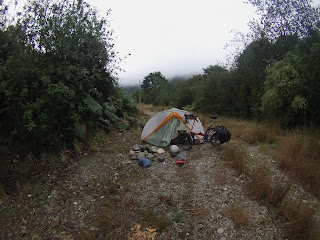Thursday, March 28, 2013
A la casa de Jorge
I had heard about Jorge from Ana and Andre, the two Brazilians I had camped with a few nights earlier. They said I should go to the small bike shop in town and ask about the casa de ciclistas. I imagined a Rastafarian man who would open his home to cyclists. After riding a tough 93km of pavement to Villa Manihuales, I stopped by a panadaria for bread with chicharones, bread, lunch meat, and dulce de leche. I asked the woman if she knew of Jorge and the bike shop, and she told me both were across the street on the corner.
A man with glasses, dress pants, dress shirt, and black dress shoes popped out the door of a small bicicliteria and 5 boys swarmed around him, all needing bicycle repairs. He patiently dealt with each one, dismounting a tire, patching, adjusting a wheel bearing, straightening handlebars.
I asked the man if he knew Jorge, who had a casa de ciclistas, and the man told me that he, indeed, was Jorge, and I was welcome to stay in his house. His home consisted of a large back yard, a garage area for bicycle repairs, a small chapel where he preached on Sundays, and a storage room. The storage room doubled as a sleeping area for the cyclists, and the work area doubled as a kitchen, with a stove and a sink.
When Jorge had fixed every bicycle presented to him, and after I had finished explaining to each boy my journey and the aspects of my bicycle and confirming the current US president several times (and pointing out that Spain was in fact in Europe, etc., etc.), Jorge was able to show me my room and point out the two guest books with messages from over 600 guests. Michael, the Polish walker had left a message. Momo, the Belgian from San Martin during New Year’s was in there. Ana and Andre. But no Urs and Gustavo. Perhaps they didn’t know of the casa de ciclistas.
Jorge had raced bicycles in his early twenties, then became an accountant. Now he worked long hours and had gained some weight. He did much missionary work, too. In 2008 he went to Cidade de Deus in Rio with a group of missionaries and lived in the favela, proselytizing to drug users. He could not run in the favela as he might be shot by either narcos or police.
He holds regular services in his home on Sundays. During the day he drives 60km (a one hour commute) to Puerto Aysen. He kept pointing to his stomach each time he mentioned accounting. He was no larger than I in my early accounting days (I was about 30 pounds heavier). He told me he wanted to work with his father, do more missionary work, run the bike shop, and spend more time with his Colombian wife and two children. In the mean time, his generosity extended to the hundreds of cyclists who passed through his doors, slept in his home, used the kitchen, bathroom, shower, and washing machine.
Early the next morning as I ate oatmeal and drank yerba mate, Jorge came out, shook my hand, and told me he had to drive to Puerto Aysen. Accounting duty called.
On the way to Jorge’s home over the last few days, I had ridden 48km of medium riding past Lago Risopatron to Puyuhuapi, where I found a camping on a man’s home on a lake and camped in his workshop and used a large common kitchen that had a wood stove to keep everyone warm at night. Two French hikers/kayakers appeared, along with Eduardo and Giulia, a Brazilian and an Italian who both loved in Floripa. All 5 of us cooked a dinner of fish, vegetables, and rice and spoke in Spanish.
Eduardo had studied philosophy, and then had explored the world and had been a chef for many years in several countries. He sold organic fruit and vegetables with Guilia in Floripa. He spoke in great detail about the North of Brasil and gave me excellent advice. A new fire was lit.
It rained heavily that night and the rain didn’t subside until just around noon, when I began to ride. I had to wash the chain off several times as an abrasive silt materialized, but the riding was beautiful along rivers and Canal Puyuhuapi. At around 5, I stopped by a river with a large, rocky shore, and prepared yerba mate and rested on a large log. A fisherman pulled up in his truck and waded out to the river to fly fish. He returned, and I asked him if he had had any luck. None. As I pulled out, he asked me if I knew of the large pass I would encounter in 5km. “Ah, buena onda,” I told him (“good times”).
Not soon after, I ran into Fletch, a man on a motorcycle from Colorado, who told me about the steep switchbacks. “But it’s only like 5 miles of switchbacks and then you’re done.” It was a wet, incredibly steep, and very foggy 8km of silty, gravel switchbacks. When I reached the summit, it was 7:40, and I only had 30 min of sunlight before all would grow pitch dark. The descent was fast, wet, bumpy, and revealed great cliffs, mountain peaks, waterfalls, and rivers. When the descent was over, I saw asphalt, the first in 6 days of riding. I didn’t have to ride for 5 minutes before finding a place to camp and cook polenta and yerba mate.
Where the cyclists sleep. 18 have slept here and in the shop during one rainy January day.
Jorge's shop.
Kitchen and workspace.
Iglesia.
























